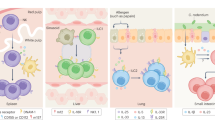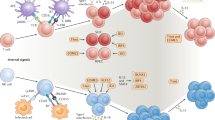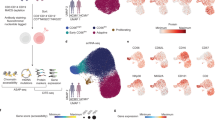Abstract
Natural killer (NK) cells are bone marrow–derived granular lymphocytes that have a key role in immune defense against viral and bacterial infections and malignancies. NK cells are traditionally defined as cells of the innate immune response because they lack RAG recombinase–dependent clonal antigen receptors. However, evidence suggests that specific subsets of mouse NK cells can nevertheless develop long-lived and highly specific memory to a variety of antigens. Here we review published evidence of NK cell–mediated, RAG-independent adaptive immunity. We also compare and contrast candidate mechanisms for mammalian NK cell memory and antigen recognition with other examples of RAG-independent pathways that generate antigen receptor diversity in non-mammalian species and discuss NK cell memory in the context of lymphocyte evolution.
This is a preview of subscription content, access via your institution
Access options
Subscribe to this journal
Receive 12 print issues and online access
$209.00 per year
only $17.42 per issue
Buy this article
- Purchase on Springer Link
- Instant access to full article PDF
Prices may be subject to local taxes which are calculated during checkout



Similar content being viewed by others
References
Bassing, C.H., Swat, W. & Alt, F.W. The mechanism and regulation of chromosomal V(D)J recombination. Cell 109, S45–S55 (2002).
Phanuphak, P., Moorhead, J.W. & Claman, H.N. Tolerance and contact sensitivity to DNFB in mice. II. Specific in vitro stimulation with a hapten, 2,4-dinitrobenzene sulfonic acid (DNB-SO3Na). J. Immunol. 112, 849–851 (1974).
Phanuphak, P., Moorhead, J.W. & Claman, H.N. Tolerance and contact sensitivity to DNFB in mice. I. In vivo detection by ear swelling and correlation with in vitro cell stimulation. J. Immunol. 112, 115–123 (1974).
Crowle, A.J. Delayed hypersensitivity in mice; its detection by skin tests and its passive transfer. Science 130, 159–160 (1959).
Quan, F.S., Huang, C., Compans, R.W. & Kang, S.M. Virus-like particle vaccine induces protective immunity against homologous and heterologous strains of influenza virus. J. Virol. 81, 3514–3524 (2007).
Herberman, R.B., Nunn, M.E. & Lavrin, D.H. Natural cytotoxic reactivity of mouse lymphoid cells against syngeneic and allogeneic tumors. I. Distribution of reactivity and specificity. Int. J. Cancer 16, 216–229 (1975).
Herberman, R.B., Nunn, M.E., Holden, H.T. & Lavrin, D.H. Natural cytotoxic reactivity of mouse lymphoid cells against syngeneic and allogeneic tumors. II. Characterization of effector cells. Int. J. Cancer 16, 230–239 (1975).
Lanier, L.L. NK cell recognition. Annu. Rev. Immunol. 23, 225–274 (2005).
Walzer, T., Dalod, M., Robbins, S.H., Zitvogel, L. & Vivier, E. Natural-killer cells and dendritic cells: “l'union fait la force”. Blood 106, 2252–2258 (2005).
Orange, J.S. Human natural killer cell deficiencies. Curr. Opin. Allergy Clin. Immunol. 6, 399–409 (2006).
O'Leary, J.G., Goodarzi, M., Drayton, D.L. & von Andrian, U.H. T cell– and B cell–independent adaptive immunity mediated by natural killer cells. Nat. Immunol. 7, 507–516 (2006).
Paust, S., Senman, B. & von Andrian, U.H. Adaptive immune responses mediated by natural killer cells. Immunol. Rev. 235, 286–296 (2010).
Sun, J.C., Beilke, J.N. & Lanier, L.L. Adaptive immune features of natural killer cells. Nature 457, 557–561 (2009).
Paust, S. et al. Critical role for the chemokine receptor CXCR6 in NK cell-mediated antigen-specific memory of haptens and viruses. Nat. Immunol. 11, 1127–1135 (2010).
Askenase, P.W. Yes T cells, but three different T cells (αβ, γδ and NK T cells), and also B-1 cells mediate contact sensitivity. Clin. Exp. Immunol. 125, 345–350 (2001).
Gorbachev, A.V. & Fairchild, R.L. Induction and regulation of T-cell priming for contact hypersensitivity. Crit. Rev. Immunol. 21, 451–472 (2001).
Boehncke, W.H. et al. Leukocyte extravasation as a target for anti-inflammatory therapy—which molecule to choose? Exp. Dermatol. 14, 70–80 (2005).
Cao, X. et al. Defective lymphoid development in mice lacking expression of the common cytokine receptor gamma chain. Immunity 2, 223–238 (1995).
DiSanto, J.P., Muller, W., Guy-Grand, D., Fischer, A. & Rajewsky, K. Lymphoid development in mice with a targeted deletion of the interleukin 2 receptor gamma chain. Proc. Natl. Acad. Sci. USA 92, 377–381 (1995).
MacDougall, J.R., Croy, B.A., Chapeau, C. & Clark, D.A. Demonstration of a splenic cytotoxic effector cell in mice of genotype SCID/SCID.BG/BG. Cell. Immunol. 130, 106–117 (1990).
Vermijlen, D. et al. High-density oligonucleotide array analysis reveals extensive differences between freshly isolated blood and hepatic natural killer cells. Eur. J. Immunol. 34, 2529–2540 (2004).
Ochi, M. et al. Liver NK cells expressing TRAIL are toxic against self hepatocytes in mice. Hepatology 39, 1321–1331 (2004).
Ishiyama, K. et al. Difference in cytotoxicity against hepatocellular carcinoma between liver and periphery natural killer cells in humans. Hepatology 43, 362–372 (2006).
Kim, S. et al. Licensing of natural killer cells by host major histocompatibility complex class I molecules. Nature 436, 709–713 (2005).
Smith, H.R. et al. Recognition of a virus-encoded ligand by a natural killer cell activation receptor. Proc. Natl. Acad. Sci. USA 99, 8826–8831 (2002).
Arase, H., Mocarski, E.S., Campbell, A.E., Hill, A.B. & Lanier, L.L. Direct recognition of cytomegalovirus by activating and inhibitory NK cell receptors. Science 296, 1323–1326 (2002).
Cooper, M.A. et al. Cytokine-induced memory-like natural killer cells. Proc. Natl. Acad. Sci. USA 106, 1915–1919 (2009).
Zhang, X., Sun, S., Hwang, I., Tough, D.F. & Sprent, J. Potent and selective stimulation of memory-phenotype CD8+ T cells in vivo by IL-15. Immunity 8, 591–599 (1998).
Sallusto, F. & Lanzavecchia, A. Heterogeneity of CD4+ memory T cells: Functional modules for tailored immunity. Eur. J. Immunol. 39, 2076–2082 (2009).
Alvarez, D., Vollmann, E.H. & von Andrian, U.H. Mechanisms and consequences of dendritic cell migration. Immunity 29, 325–342 (2008).
Catalina, M.D. et al. The route of antigen entry determines the requirement for L-selectin during immune responses. J. Exp. Med. 184, 2341–2351 (1996).
Bajenoff, M. et al. Natural killer cell behavior in lymph nodes revealed by static and real-time imaging. J. Exp. Med. 203, 619–631 (2006).
Jenne, C.N. et al. T-bet-dependent S1P5 expression in NK cells promotes egress from lymph nodes and bone marrow. J. Exp. Med. 206, 2469–2481 (2009).
Morris, M.A. & Ley, K. Trafficking of natural killer cells. Curr. Mol. Med. 4, 431–438 (2004).
Geissmann, F. et al. Intravascular immune surveillance by CXCR6+ NKT cells patrolling liver sinusoids. PLoS Biol. 3, e113 (2005).
Hunger, R.E., Yawalkar, N., Braathen, L.R. & Brand, C.U. The HECA-452 epitope is highly expressed on lymph cells derived from human skin. Br. J. Dermatol. 141, 565–569 (1999).
Carbone, T. et al. CD56highCD16−CD62L− NK cells accumulate in allergic contact dermatitis and contribute to the expression of allergic responses. J. Immunol. 184, 1102–1110 (2010).
Weninger, W. et al. Specialized contributions by α(1,3)-fucosyltransferase-IV and FucT-VII during leukocyte rolling in dermal microvessels. Immunity 12, 665–676 (2000).
Buentke, E. et al. Natural killer and dendritic cell contact in lesional atopic dermatitis skin—Malassezia-influenced cell interaction. J. Invest. Dermatol. 119, 850–857 (2002).
van der Voort, R. et al. An alternatively spliced CXCL16 isoform expressed by dendritic cells is a secreted chemoattractant for CXCR6+ cells. J. Leukoc. Biol. 87, 1029–1039 (2010).
Calabresi, P.A., Yun, S.H., Allie, R. & Whartenby, K.A. Chemokine receptor expression on MBP-reactive T cells: CXCR6 is a marker of IFNγ-producing effector cells. J. Neuroimmunol. 127, 96–105 (2002).
Raulet, D.H. Roles of the NKG2D immunoreceptor and its ligands. Nat. Rev. Immunol. 3, 781–790 (2003).
Ferlazzo, G. et al. The interaction between NK cells and dendritic cells in bacterial infections results in rapid induction of NK cell activation and in the lysis of uninfected dendritic cells. Eur. J. Immunol. 33, 306–313 (2003).
Jinushi, M. et al. Natural killer cell and hepatic cell interaction via NKG2A leads to dendritic cell-mediated induction of CD4 CD25 T cells with PD-1-dependent regulatory activities. Immunology 120, 73–82 (2007).
Nocentini, G., Ronchetti, S., Cuzzocrea, S. & Riccardi, C. GITR/GITRL: more than an effector T cell co-stimulatory system. Eur. J. Immunol. 37, 1165–1169 (2007).
Martin-Fontecha, A. et al. Induced recruitment of NK cells to lymph nodes provides IFN-γ for TH1 priming. Nat. Immunol. 5, 1260–1265 (2004).
Gao, N., Dang, T. & Yuan, D. IFN-gamma-dependent and -independent initiation of switch recombination by NK cells. J. Immunol. 167, 2011–2018 (2001).
Lunemann, A., Lunemann, J.D. & Munz, C. Regulatory NK-cell functions in inflammation and autoimmunity. Mol. Med. 15, 352–358 (2009).
Namekawa, T. et al. Killer cell activating receptors function as costimulatory molecules on CD4+CD28null T cells clonally expanded in rheumatoid arthritis. J. Immunol. 165, 1138–1145 (2000).
Martin, M.P. et al. Cutting edge: susceptibility to psoriatic arthritis: influence of activating killer Ig-like receptor genes in the absence of specific HLA-C alleles. J. Immunol. 169, 2818–2822 (2002).
Momot, T. et al. Association of killer cell immunoglobulin-like receptors with scleroderma. Arthritis Rheum. 50, 1561–1565 (2004).
Suzuki, Y. et al. Genetic polymorphisms of killer cell immunoglobulin-like receptors are associated with susceptibility to psoriasis vulgaris. J. Invest. Dermatol. 122, 1133–1136 (2004).
Hedman, M., Faresjo, M., Axelsson, S., Ludvigsson, J. & Casas, R. Impaired CD4 and CD8 T cell phenotype and reduced chemokine secretion in recent-onset type 1 diabetic children. Clin. Exp. Immunol. 153, 360–368 (2008).
Kim, J.V. et al. Two-photon laser scanning microscopy imaging of intact spinal cord and cerebral cortex reveals requirement for CXCR6 and neuroinflammation in immune cell infiltration of cortical injury sites. J. Immunol. Methods 352, 89–100 (2009).
Ivakine, E.A. et al. Molecular genetic analysis of the Idd4 locus implicates the IFN response in type 1 diabetes susceptibility in nonobese diabetic mice. J. Immunol. 176, 2976–2990 (2006).
Garcia, G.E. et al. Inhibition of CXCL16 attenuates inflammatory and progressive phases of anti-glomerular basement membrane antibody-associated glomerulonephritis. Am. J. Pathol. 170, 1485–1496 (2007).
Sordi, V. et al. Bone marrow mesenchymal stem cells express a restricted set of functionally active chemokine receptors capable of promoting migration to pancreatic islets. Blood 106, 419–427 (2005).
Teramoto, K. et al. Microarray analysis of glomerular gene expression in murine lupus nephritis. J. Pharmacol. Sci. 106, 56–67 (2008).
Ruth, J.H. et al. CXCL16-mediated cell recruitment to rheumatoid arthritis synovial tissue and murine lymph nodes is dependent upon the MAPK pathway. Arthritis Rheum. 54, 765–778 (2006).
Aslanian, A.M. & Charo, I.F. Targeted disruption of the scavenger receptor and chemokine CXCL16 accelerates atherosclerosis. Circulation 114, 583–590 (2006).
Galkina, E. & Ley, K. Leukocyte influx in atherosclerosis. Curr. Drug Targets 8, 1239–1248 (2007).
Wuttge, D.M. et al. CXCL16/SR-PSOX is an interferon-γ-regulated chemokine and scavenger receptor expressed in atherosclerotic lesions. Arterioscler. Thromb. Vasc. Biol. 24, 750–755 (2004).
Jiang, X. et al. Cutting edge: critical role of CXCL16/CXCR6 in NKT cell trafficking in allograft tolerance. J. Immunol. 175, 2051–2055 (2005).
Bouazzaoui, A. et al. Chemokine and chemokine receptor expression analysis in target organs of acute graft-versus-host disease. Genes Immun. 10, 687–701 (2009).
Matsumura, K. et al. Radioimmunoscintigraphy of pancreatic cancer in tumor-bearing athymic nude mice using 99mtechnetium-labeled anti-KL-6/MUC1 antibody. Radiat. Med. 26, 133–139 (2008).
Seidl, H. et al. Profiles of chemokine receptors in melanocytic lesions: de novo expression of CXCR6 in melanoma. Hum. Pathol. 38, 768–780 (2007).
Gutwein, P. et al. Tumoural CXCL16 expression is a novel prognostic marker of longer survival times in renal cell cancer patients. Eur. J. Cancer 45, 478–489 (2009).
Wang, J., Lu, Y., Koch, A.E., Zhang, J. & Taichman, R.S. CXCR6 induces prostate cancer progression by the AKT/mammalian target of rapamycin signaling pathway. Cancer Res. 68, 10367–10376 (2008).
Meijer, J. et al. The chemokine receptor CXCR6 and its ligand CXCL16 are expressed in carcinomas and inhibit proliferation. Cancer Res. 68, 4701–4708 (2008).
Liao, F. et al. STRL33, A novel chemokine receptor-like protein, functions as a fusion cofactor for both macrophage-tropic and T cell line-tropic HIV-1. J. Exp. Med. 185, 2015–2023 (1997).
Limou, S. et al. Multiple-cohort genetic association study reveals CXCR6 as a new chemokine receptor involved in long-term nonprogression to AIDS. J. Infect. Dis. 202, 908–915 (2010).
Blaak, H. et al. CCR5, GPR15, and CXCR6 are major coreceptors of human immunodeficiency virus type 2 variants isolated from individuals with and without plasma viremia. J. Virol. 79, 1686–1700 (2005).
Duggal, P. et al. Genetic influence of CXCR6 chemokine receptor alleles on PCP-mediated AIDS progression among African Americans. Genes Immun. 4, 245–250 (2003).
Lanier, L.L. Up on the tightrope: natural killer cell activation and inhibition. Nat. Immunol. 9, 495–502 (2008).
Lanier, L.L. Evolutionary struggles between NK cells and viruses. Nat. Rev. Immunol. 8, 259–268 (2008).
Scalzo, A.A., Manzur, M., Forbes, C.A., Brown, M.G. & Shellam, G.R. NK gene complex haplotype variability and host resistance alleles to murine cytomegalovirus in wild mouse populations. Immunol. Cell Biol. 83, 144–149 (2005).
Gazit, R. et al. Lethal influenza infection in the absence of the natural killer cell receptor gene Ncr1. Nat. Immunol. 7, 517–523 (2006).
Mandelboim, O. et al. Recognition of haemagglutinins on virus-infected cells by NKp46 activates lysis by human NK cells. Nature 409, 1055–1060 (2001).
Yokoyama, W.M. & Kim, S. Licensing of natural killer cells by self-major histocompatibility complex class I. Immunol. Rev. 214, 143–154 (2006).
Bjorkstrom, N.K. et al. Rapid expansion and long-term persistence of elevated NK cell numbers in humans infected with hantavirus. J. Exp. Med 208, 13–21 (2011).
Martin, M.P. et al. Epistatic interaction between KIR3DS1 and HLA-B delays the progression to AIDS. Nat. Genet. 31, 429–434 (2002).
Khakoo, S.I. et al. HLA and NK cell inhibitory receptor genes in resolving hepatitis C virus infection. Science 305, 872–874 (2004).
Reeves, R.K. et al. CD16- natural killer cells: enrichment in mucosal and secondary lymphoid tissues and altered function during chronic SIV infection. Blood 115, 4439–4446 (2011).
Berahovich, R.D., Lai, N.L., Wei, Z., Lanier, L.L. & Schall, T.J. Evidence for NK cell subsets based on chemokine receptor expression. J. Immunol. 177, 7833–7840 (2006).
Cooper, M.D. & Alder, M.N. The evolution of adaptive immune systems. Cell 124, 815–822 (2006).
Vosshenrich, C.A. et al. A thymic pathway of mouse natural killer cell development characterized by expression of GATA-3 and CD127. Nat. Immunol. 7, 1217–1224 (2006).
Fernandez-Busquets, X. & Burger, M.M. The main protein of the aggregation factor responsible for species-specific cell adhesion in the marine sponge Microciona prolifera is highly polymorphic. J. Biol. Chem. 272, 27839–27847 (1997).
Nicotra, M.L. et al. A hypervariable invertebrate allodeterminant. Curr. Biol. 19, 583–589 (2009).
Joly, E. Various hypotheses on MHC evolution suggested by the concerted evolution of CD94L and MHC class Ia molecules. Biol. Direct 1, 3 (2006).
Zucchetti, I. et al. ciCD94–1, an ascidian multipurpose C-type lectin-like receptor expressed in Ciona intestinalis hemocytes and larval neural structures. Differentiation 76, 267–282 (2008).
Flajnik, M.F. & Kasahara, M. Origin and evolution of the adaptive immune system: genetic events and selective pressures. Nat. Rev. Genet 11, 47–59 (2010).
Guo, P. et al. Dual nature of the adaptive immune system in lampreys. Nature 459, 796–801 (2009).
Uinuk-Ool, T.S. et al. Phylogeny of antigen-processing enzymes: cathepsins of a cephalochordate, an agnathan and a bony fish. Scand. J. Immunol. 58, 436–448 (2003).
Uinuk-ool, T.S. et al. Identification and characterization of a TAP-family gene in the lamprey. Immunogenetics 55, 38–48 (2003).
Tsutsui, S., Nakamura, O. & Watanabe, T. Lamprey (Lethenteron japonicum) IL-17 upregulated by LPS-stimulation in the skin cells. Immunogenetics 59, 873–882 (2007).
von Andrian, U.H. & Mempel, T.R. Homing and cellular traffic in lymph nodes. Nat. Rev. Immunol. 3, 867–878 (2003).
Galkina, E. et al. CXCR6 promotes atherosclerosis by supporting T-cell homing, interferon-γ production, and macrophage accumulation in the aortic wall. Circulation 116, 1801–1811 (2007).
Latta, M., Mohan, K. & Issekutz, T.B. CXCR6 is expressed on T cells in both T helper type 1 (Th1) inflammation and allergen-induced Th2 lung inflammation but is only a weak mediator of chemotaxis. Immunology 121, 555–564 (2007).
Diegelmann, J. et al. Expression and regulation of the chemokine CXCL16 in Crohn's disease and models of intestinal inflammation. Inflamm. Bowel Dis. 16, 1871–1881 (2010).
Matsumura, S. et al. Radiation-induced CXCL16 release by breast cancer cells attracts effector T cells. J. Immunol. 181, 3099–3107 (2008).
Liao, F. et al. STRL33, a novel chemokine receptor-like protein, functions as a fusion cofactor for both macrophage-tropic and T cell line-tropic HIV-1. J. Exp. Med. 185, 2015–2023 (1997).
Heydtmann, M. et al. CXC chemokine ligand 16 promotes integrin-mediated adhesion of liver-infiltrating lymphocytes to cholangiocytes and hepatocytes within the inflamed human liver. J. Immunol. 174, 1055–1062 (2005).
Sato, T. et al. Role for CXCR6 in recruitment of activated CD8+ lymphocytes to inflamed liver. J. Immunol. 174, 277–283 (2005).
Oh, S.T., Schramme, A., Tilgen, W., Gutwein, P. & Reichrath, J. Overexpression of CXCL16 in lesional psoriatic skin. Dermatoendocrinol. 1, 114–118 (2009).
Martini, G. et al. CXCR6-CXCL16 interaction in the pathogenesis of Juvenile Idiopathic Arthritis. Clin. Immunol. 129, 268–276 (2008).
van der Voort, R. et al. Elevated CXCL16 expression by synovial macrophages recruits memory T cells into rheumatoid joints. Arthritis Rheum. 52, 1381–1391 (2005).
Nanki, T. et al. Pathogenic role of the CXCL16-CXCR6 pathway in rheumatoid arthritis. Arthritis Rheum. 52, 3004–3014 (2005).
Acknowledgements
Supported by the Cancer Research Institute (S.P.), the Ragon Institute of MGH, MIT and Harvard (S.P. and U.H.v.A.) and the US National Institutes of Health (AI069259, AI072252 and AI1078897 to U.H.v.A.).
Author information
Authors and Affiliations
Corresponding author
Ethics declarations
Competing interests
The authors declare no competing financial interests.
Rights and permissions
About this article
Cite this article
Paust, S., von Andrian, U. Natural killer cell memory. Nat Immunol 12, 500–508 (2011). https://doi.org/10.1038/ni.2032
Published:
Issue Date:
DOI: https://doi.org/10.1038/ni.2032
This article is cited by
-
Advances in NK cell production
Cellular & Molecular Immunology (2022)
-
Natural Killer Cells Recruitment in Oncolytic Virotherapy: A Mathematical Model
Bulletin of Mathematical Biology (2021)
-
The untwining of immunosenescence and aging
Seminars in Immunopathology (2020)
-
Liver-resident NK cells and their potential functions
Cellular & Molecular Immunology (2017)
-
Natural killer cell memory in infection, inflammation and cancer
Nature Reviews Immunology (2016)



